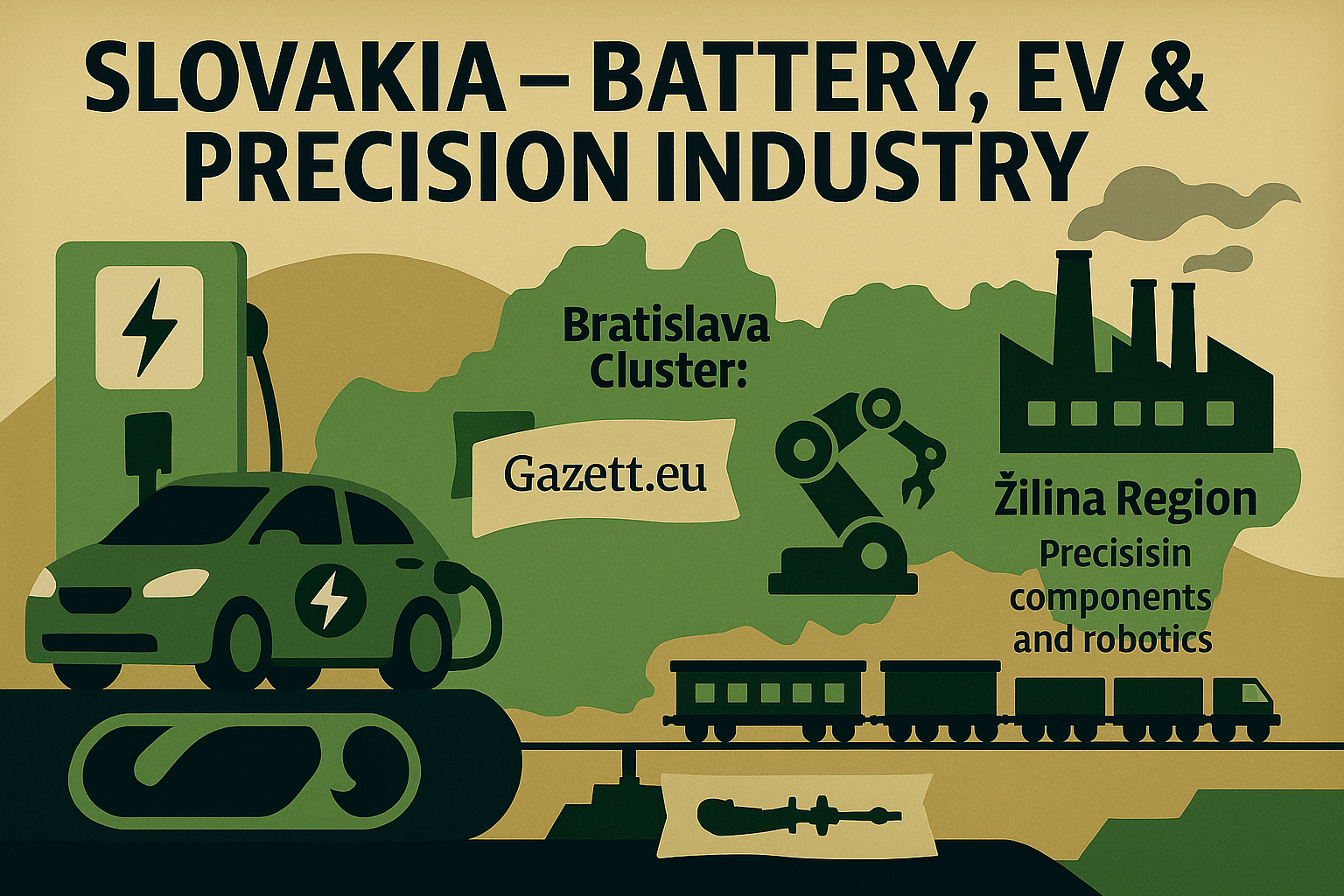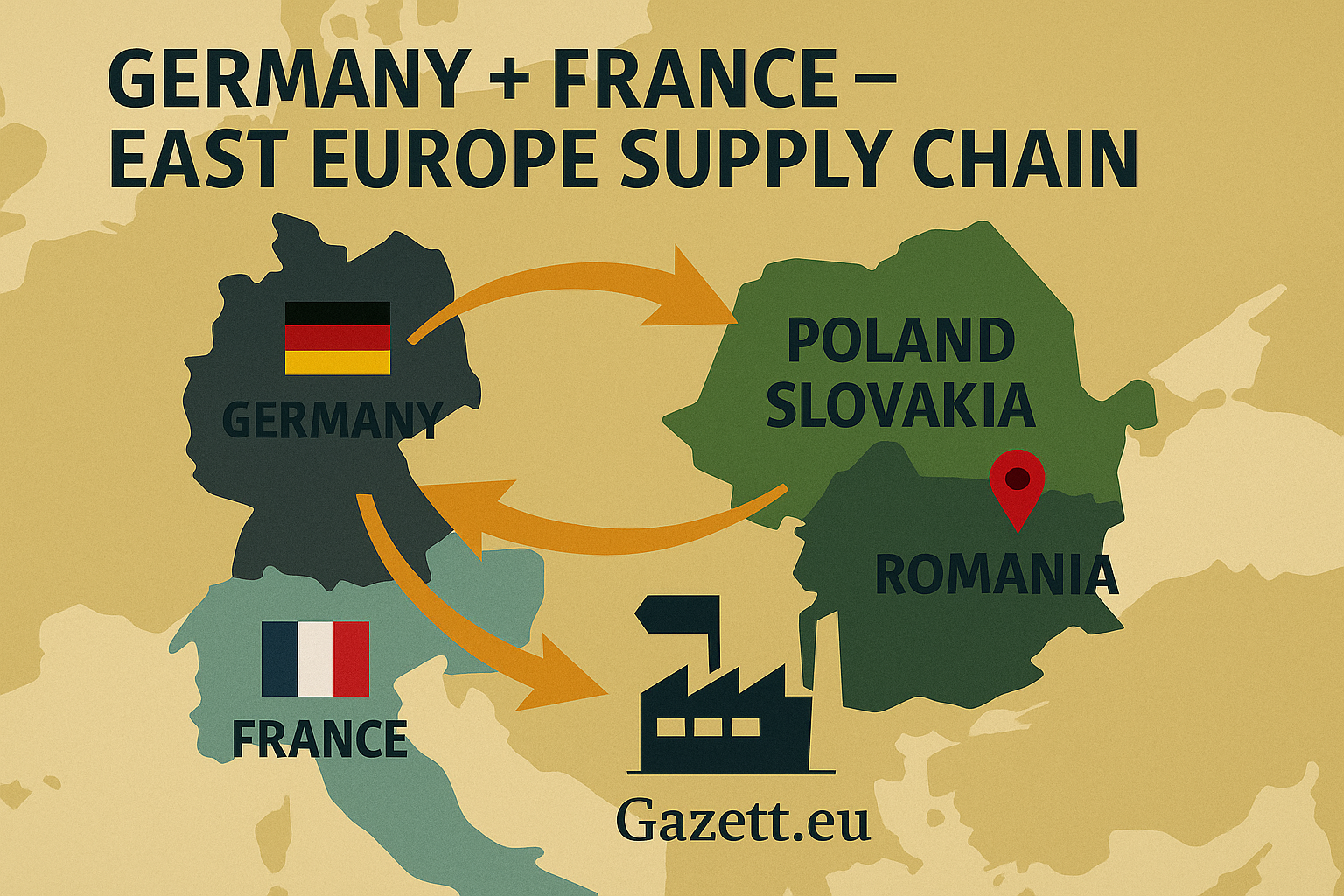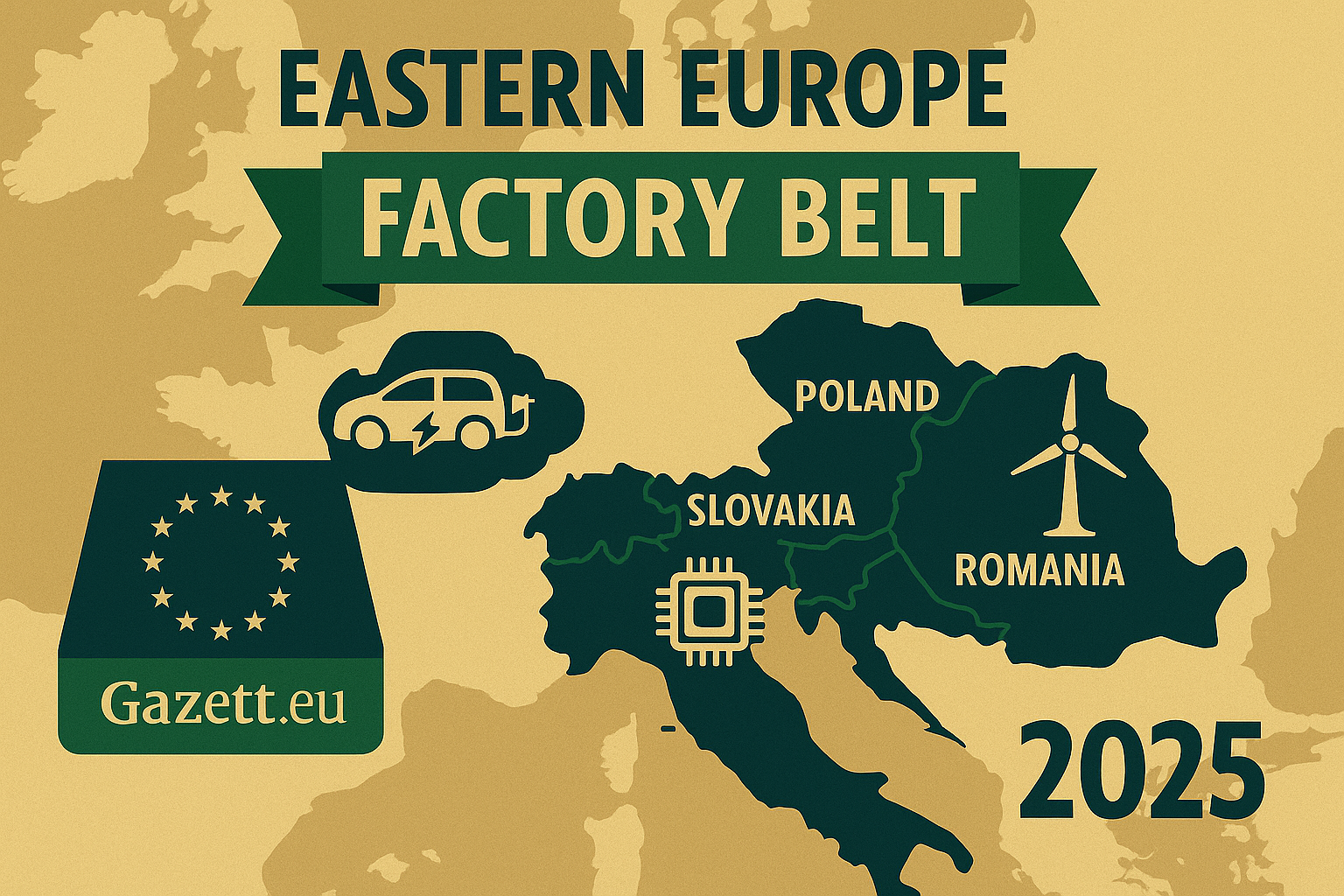🏗️ Eastern Europe’s Rise: Poland, Romania, Slovakia as New EU Factory Hubs
In 2025, Eastern Europe is emerging as the EU’s most dynamic industrial growth zone. Poland, Romania, and Slovakia are attracting record FDI, scaling new production zones, and strengthening supply chain ties with Germany and France. As labor costs in Western Europe rise and supply chains shift inward, the region is becoming a strategic engine of Europe’s manufacturing revival.
In this article, we explore how these countries are using cost competitiveness, EU structural funds, and regional infrastructure upgrades to become indispensable players in reshored, resilient European production.

📚 Table of Contents
- 1. Why Eastern Europe? Key Growth Drivers
- 2. Poland: Automotive & Appliance Hub
- 3. Romania: Tech Assembly and Logistics Gateway
- 4. Slovakia: Battery, EV, and Precision Components
- 5. EU Funding & Infrastructure Integration
- 6. Supply Chain Ties with Germany & France
- 7. Outlook: Eastern Europe as Europe’s Factory Belt
- ✅ Conclusion
🚀 Why Eastern Europe? Key Growth Drivers
The rise of Poland, Romania, and Slovakia as EU manufacturing hotspots is no accident. These countries offer a rare mix of competitive labor costs, geographic advantage, and massive inflows of EU development funds. With proximity to core markets like Germany and France, they are now top choices for supply chain diversification and cost-efficient industrial expansion.
According to Eurostat and OECD data, average industrial wages in these countries are still 40–60% lower than Western Europe — but infrastructure, logistics, and workforce skill levels are rapidly catching up. That combination is driving long-term foreign direct investment (FDI) into advanced manufacturing, electronics, clean energy equipment, and auto components.

- 💶 Labor Advantage: 40–60% lower industrial wages vs. Germany or France
- 🚛 Geographic Proximity: Road and rail connectivity to Central & Western Europe
- 🏗️ EU Structural Funds: Billions in industrial zones, rail, and trade logistics
- 🏭 Ready Industrial Base: Legacy industries now upgraded with modern tech
- 📈 FDI Momentum: Global firms reshoring into Poland, Romania, and Slovakia
This surge is part of a wider transformation detailed in our latest analysis on Europe’s eastward industrial shift.
Internal source: Gazett.eu | Related: Europe’s Industrial Shift Eastward
🚗 Poland – Automotive & Appliance Hub
Poland has become the undisputed industrial heavyweight of Eastern Europe. In 2025, the country is not only a manufacturing giant in the region — it's also one of the EU’s most attractive reshoring destinations for German and Korean OEMs, driven by its robust industrial zones in Katowice, Wrocław, and Łódź.
The country specializes in automotive components, home appliances, and electronics assembly, thanks to a strong vocational workforce and streamlined EU trade logistics. Brands like LG, Whirlpool, Mercedes, and Stellantis have all expanded operations in Poland over the last three years.

- 🏭 Katowice Zone: Automotive clusters, batteries, smart appliances
- 🚚 Łódź Region: EU logistics and consumer goods manufacturing
- ⚙️ Wrocław Hub: Electronics, automation components, motors
- 📉 Labor Advantage: Avg. wages still ~55% lower than Germany
- 📈 2025 FDI Surge: €9.2B in new industrial investment YTD
Poland’s role in the reshoring shift is expanding. See how its growth supports German supply chains moving east.
Internal source: Gazett.eu | Related: Germany Supply Chain Reshoring East
🚛 Romania – Tech Assembly & Logistics Gateway
Romania is fast becoming the logistics and electronics backbone of Eastern Europe. With strategic ports on the Black Sea, proximity to Central Europe, and new infrastructure linking it to pan-EU rail corridors, Romania is now a go-to destination for tech assembly, warehousing, and export logistics.
The country’s Bucharest–Ploiești–Cluj industrial triangle is booming with investments in semiconductors, white goods, solar panels, and circuit board assembly. Major multinationals like Bosch, Continental, and Samsung have all expanded operations in Romania since 2022.

- 🚢 Constanța Port: Black Sea export-import gateway for Asia and MENA
- 🏙️ Bucharest–Cluj Corridor: Electronics, chips, smart grid tech, light assembly
- 🚆 Pan-EU Rail Access: Connectivity with Poland, Hungary, Germany
- 💼 Skilled Workforce: High STEM graduate rate and tech-oriented SMEs
- 📦 Nearshoring Destination: Growing role as EU’s Southeast logistics platform
Romania’s industrial footprint is rising. Learn how it’s reshaping the region’s supply strategy in our feature on Romania’s Black Sea logistics boom.
Internal source: Gazett.eu | Related: Romania’s Supply Chain Role 2025
🔋 Slovakia – Battery, EV & Precision Components
Slovakia has carved out a powerful niche in high-value automotive and precision manufacturing. With one of the highest per-capita car production rates in the world, the country is now evolving into a European hub for battery systems, EV platforms, and metal precision parts essential for green mobility and smart industry.
Anchored by foreign giants like Kia, Volkswagen, and Stellantis, Slovakia’s industrial clusters in Bratislava and Žilina are also seeing a rise in advanced robotics suppliers and battery cell investments — many of which are backed by EU innovation funds and German-Slovak joint ventures.

- 🚗 Bratislava Cluster: EV platforms, battery tech, German OEMs
- 🔩 Žilina Region: Precision components, machining, and robotics
- 📦 Integrated Supply Chain: Rail-linked to Poland, Czechia, Austria
- ⚙️ Skilled Engineering Talent: Strong vocational and mechatronics base
- 📈 EV Investment Growth: €6B+ in battery & e-mobility projects since 2023
Slovakia’s industrial strategy aligns tightly with Europe’s EV and clean mobility goals. Read our overview on EV production shifts in Central Europe for a broader picture.
Internal source: Gazett.eu | Related: Central Europe’s EV Supply Chain 2025
💶 EU Funding & Infrastructure Integration
Eastern Europe’s rise as an industrial base is powered not just by private investment, but by unprecedented EU structural and cohesion funding. Between 2021 and 2027, Poland, Romania, and Slovakia are set to receive over €110 billion combined for infrastructure, digitalization, and regional development — much of it tied to manufacturing ecosystems.
Massive upgrades are underway in rail freight corridors, cross-border logistics terminals, and industrial digital hubs. These efforts are not only stitching Eastern Europe into the EU’s supply chain web, but are also enhancing connectivity with Germany, Austria, and northern Italy via the TEN-T (Trans-European Transport Network).

- 🚄 TEN-T Corridors: Key rail & road routes upgraded across Eastern Europe
- 📦 Multimodal Logistics: New EU-funded terminals in Slovakia, Romania, Poland
- 🔌 Digital Industrial Parks: High-speed fiber and IoT-ready zones supported by EU
- 💰 €110B+ in Total EU Funds: Allocated for industrial-linked development (2021–2027)
- 🌍 Green & Resilient: Most projects linked to EU climate & resilience goals
For a deeper dive into EU infrastructure priorities, explore our companion feature on TEN-T corridors and regional manufacturing growth.
Internal source: Gazett.eu | Related: EU Infrastructure Plans 2025
🔗 Supply Chain Ties with Germany & France
One of the biggest reasons Eastern Europe is thriving as a factory hub is its deep and growing integration with Germany’s and France’s supply chains. Major OEMs, Tier 1 and Tier 2 suppliers from both countries have increasingly relocated or outsourced parts of their manufacturing to Poland, Romania, and Slovakia — creating a seamless cross-border ecosystem.
Germany’s auto giants — from Volkswagen and BMW to Bosch — have decades-long presences in Slovakia and Poland. Meanwhile, French conglomerates like Renault, Schneider Electric, and Valeo are scaling component production and final assembly in Romania.

- 🇩🇪 Germany → Slovakia/Poland: Auto, precision tools, industrial robotics
- 🇫🇷 France → Romania: Smart grids, vehicle electronics, modular assemblies
- 🚛 Just-in-Time Logistics: Border-integrated hubs for seamless EU operations
- ⚙️ Dual-Plant Strategy: Many firms run one R&D base in Germany and production in the East
- 🔄 Mutual Interdependence: Over 40% of Eastern European exports go to DE/FR
This emerging “twin-engine model” of Western R&D + Eastern production is shaping Europe’s industrial future. Read more in our regional breakdown of Germany–France–Eastern Europe integration.
Internal source: Gazett.eu | Related: Germany–France–Eastern Europe Strategy
🏁 Outlook: Eastern Europe as Europe’s Factory Belt
As reshoring accelerates, industrial policy aligns, and infrastructure deepens, Eastern Europe is no longer just a low-cost alternative — it is becoming Europe’s strategic manufacturing belt. With ties to Germany and France, ports and rail to the wider world, and targeted EU funding, this trio of nations is rewriting the continent’s industrial map.
The region’s strengths now go beyond cost: engineering talent, automation, digital logistics, and energy-smart zones are propelling long-term competitiveness. The industrial future of the EU won’t be centered in one place — it will stretch from Wrocław to Bucharest to Bratislava.

- 🧱 Resilient Base: Poland, Romania, and Slovakia are now industrial cornerstones
- 🛠️ Product Mix: EVs, appliances, semiconductors, robotics, clean energy components
- 🛰️ Smart Infrastructure: EU-enabled digital, energy, and mobility platforms
- 🧠 STEM Talent: Regional tech universities fueling workforce of the future
- 🚀 Strategic Role: The backbone of EU's reindustrialization and global export drive
Want to dive deeper? Don’t miss our visual editorial on Europe’s factory belt transformation.
Internal source: Gazett.eu | Related: Eastern Europe – EU Factory Belt 2025
✅ Conclusion: Eastern Europe’s Industrial Moment
From factory floors in Katowice to rail hubs in Cluj and EV labs in Bratislava, Eastern Europe is now central to the EU’s manufacturing revival. This transformation isn’t just about cost — it’s about capacity, climate alignment, and continental resilience.
Poland, Romania, and Slovakia are proving that strategic funding, connectivity, and skilled labor can power global competitiveness. The EU’s industrial future will depend on this “factory belt” more than ever.
📊 Quick Summary Table
| Country | Focus Industry | Key Cities/Zones |
|---|---|---|
| Poland | Auto parts, appliances, electronics | Katowice, Łódź, Wrocław |
| Romania | Tech assembly, logistics, chips | Bucharest, Cluj, Constanța |
| Slovakia | Batteries, EV, precision tools | Bratislava, Žilina |